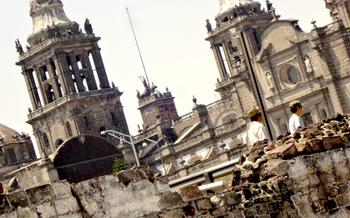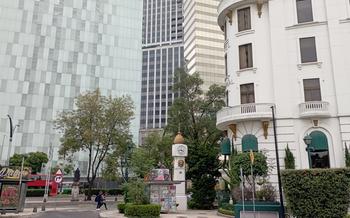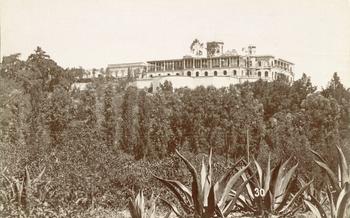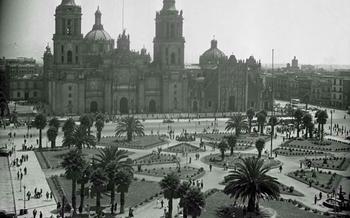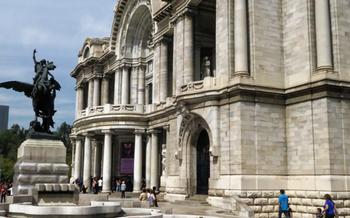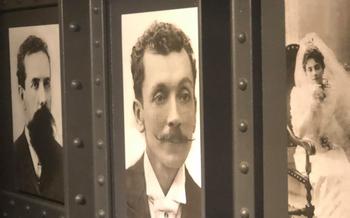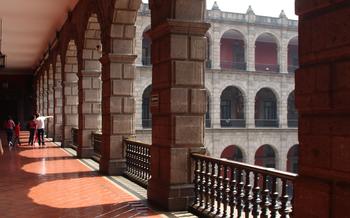
Museo Nacional de Historia (Castle of Chapultepec)
- Museo Nacional de Historia (Castle of Chapultepec): A Majestic Historical as the country itself, beginning as a military fortress in the 18th century and evolving into a lavish presidential residence during the 19th and 20th centuries. Today, it serves as a museum dedicated to preserving and showcasing Mexico's cultural heritage, inviting visitors to journey through time and immerse themselves in the stories of a nation.
- Location and Getting There: A Journey to the Heart of Mexico City
- Hours of Operation and Admission Fees: Planning Your Visit
- Unveiling the History of Chapultepec Castle: A Tapestry of Empires
- Architectural Marvels: Exploring the Castle's Splendid Design
- Artistic Treasures: A Journey Through Mexican Art and History
- A Walk Through History: Exploring the Castle's Thematic Rooms
- Presidential Legacy: Tracing the Footsteps of Mexico's Leaders
- Panoramic Views: A Breathtaking Vista of Mexico City
- Accessibility and Facilities: Ensuring a Comfortable Visit
- Educational Opportunities: Workshops and Learning Experiences
- Nearby Attractions: Exploring Chapultepec Park and Beyond
- Photography and Videography: Capturing the Castle's Grandeur
- Insider Tip: Unveiling the Secret Gardens
Museo Nacional de Historia (Castle of Chapultepec): A Majestic Historical as the country itself, beginning as a military fortress in the 18th century and evolving into a lavish presidential residence during the 19th and 20th centuries. Today, it serves as a museum dedicated to preserving and showcasing Mexico's cultural heritage, inviting visitors to journey through time and immerse themselves in the stories of a nation.
Within its grand halls and galleries, the castle houses an extensive collection of artifacts, paintings, sculptures, and historical documents that narrate the evolution of Mexican society, from pre-Columbian civilizations to the present day. Visitors can trace the footsteps of Mexico's past leaders and dignitaries who once graced the castle's opulent chambers, leaving an indelible mark on the nation's history.
From the castle's terraces, visitors are treated to breathtaking panoramic views of Mexico City and the surrounding landscape. The cityscape stretches out before them, a tapestry of modern skyscrapers and colonial-era buildings, while the majestic mountains in the distance frame this vibrant metropolis. Whether bathed in the warm glow of dawn, the vibrant hues of dusk, or the twinkling lights of the night sky, the views from the castle are simply mesmerizing.
Location and Getting There: A Journey to the Heart of Mexico City
Reaching the Museo Nacional de Historia, also known as Chapultepec Castle, is a convenient and straightforward journey. Nestled atop Chapultepec Hill in the heart of Mexico City, the castle enjoys a strategic location easily accessible by various transportation options.
For those who prefer public transportation, the Metrobus line 7, commonly known as the "Red Line," offers a direct route to the castle. Disembark at the Chapultepec station, and a short walk through the park will lead you to the castle's entrance. Alternatively, numerous bus lines, including routes 1, 5, 11, 27, 76, and 110, have stops near the castle, providing convenient access from different parts of the city.
If you opt for the scenic route, consider taking a leisurely stroll through Chapultepec Park, Mexico City's largest and most iconic green space. The park's sprawling grounds offer a delightful prelude to your visit, with lush gardens, tranquil fountains, and historic landmarks lining your path to the castle.
Once you arrive at the castle, you'll find ample parking spaces available, ensuring a hassle-free visit. Whether you choose to drive or utilize public transportation, the Museo Nacional de Historia is effortlessly accessible, inviting you to step into the grandeur of Mexico's rich past.
Hours of Operation and Admission Fees: Planning Your Visit
The Museo Nacional de Historia, housed within the majestic Chapultepec Castle, welcomes visitors from Tuesday to Sunday, offering a captivating journey through Mexican history and culture. The castle's doors open at 9:00 AM and remain open until 5:00 PM, inviting visitors to immerse themselves in its grandeur and explore its many wonders.
Admission fees are structured to ensure accessibility for all. Adults can purchase tickets for a modest fee, while children, students, and seniors are eligible for discounted rates. Visitors are encouraged to take advantage of the guided tours offered by knowledgeable and passionate historians, who bring the castle's stories to life with their insightful commentary and anecdotes.
To enhance the visitor experience, the castle provides audio guides in multiple languages, allowing visitors to explore at their own pace while gaining valuable insights into the exhibits. These audio guides offer a wealth of information, shedding light on the historical significance of the castle and its many treasures.
Planning a visit during the week, particularly on weekdays, is recommended to avoid the larger crowds that tend to gather on weekends and holidays. This allows visitors to fully appreciate the castle's tranquility and engage with its exhibits without feeling rushed.
Unveiling the History of Chapultepec Castle: A Tapestry of Empires
Over the centuries, Chapultepec Castle has witnessed the rise and fall of empires, playing a pivotal role in shaping Mexico's tumultuous history. Originally constructed as a military academy in the late 18th century, the castle's strategic location atop Chapultepec Hill made it a coveted prize during numerous conflicts.
During the Mexican-American War, the castle served as a stronghold for Mexican forces, valiantly resisting the invading American troops. The battle-scarred walls of the castle bear witness to the fierce fighting that took place within its grounds.
Following the war, the castle underwent extensive renovations and was transformed into a lavish presidential residence. Emperor Maximilian I, the ill-fated ruler of Mexico during the Second Mexican Empire, made the castle his grand palace, leaving his mark with opulent furnishings and intricate decorations.
After the fall of the empire, the castle once again became the residence of Mexico's presidents. Notable figures such as Porfirio Díaz, the long-serving dictator, and Lázaro Cárdenas, the visionary reformer, have all graced the halls of the castle, leaving their own unique legacies on Mexico's political landscape.
Today, Chapultepec Castle stands as a symbol of Mexico's rich and complex history, a testament to the nation's resilience and enduring spirit. Its walls whisper tales of battles fought, empires won and lost, and the lives of the extraordinary individuals who shaped Mexico's destiny.
Architectural Marvels: Exploring the Castle's Splendid Design
The Museo Nacional de Historia, housed within Chapultepec Castle, showcases a remarkable blend of architectural styles that reflects Mexico's rich history and cultural heritage. Its design seamlessly merges European influences, particularly French and Italian Renaissance elements, with traditional Mexican motifs. The castle's exterior boasts a striking neoclassical facade adorned with intricate carvings, arches, and balconies. The grand staircase, a focal point of the interior, is an architectural masterpiece in itself, featuring a sweeping double staircase with ornate balustrades and a domed ceiling adorned with frescoes.
Inside the castle, visitors can marvel at the opulent chandeliers, murals, and tapestries that adorn the walls and ceilings of the grand halls and galleries. The Throne Room, once used by Emperor Maximilian I, is a testament to the castle's imperial past, showcasing a lavish interior with gilded furniture, opulent chandeliers, and a majestic throne. The murals by renowned Mexican artist David Alfaro Siqueiros, depicting scenes from Mexico's history, add depth and vibrancy to the castle's interior spaces.
The castle's design is not merely an aesthetic display; it also holds symbolic significance. The fusion of European and Mexican architectural elements represents Mexico's unique identity as a nation that has embraced both its indigenous roots and its colonial heritage. The castle's strategic location atop Chapultepec Hill further emphasizes its symbolic importance, as it has served as a symbol of power and authority throughout Mexico's history.
To fully appreciate the architectural marvels of the Museo Nacional de Historia, visitors are encouraged to take their time exploring the castle's numerous rooms and galleries. Each space offers a unique perspective on the castle's architectural evolution and the stories it holds. Whether it's the grand staircase, the Throne Room, or the hidden courtyards, the castle's architectural details reveal the artistry, craftsmanship, and historical significance that make it a must-visit destination in Mexico City.
Artistic Treasures: A Journey Through Mexican Art and History
The Museo Nacional de Historia houses an extensive collection of artifacts, paintings, sculptures, and historical documents that offer a comprehensive journey through Mexican art and history. Visitors can explore galleries dedicated to pre-Columbian art, colonial-era paintings, and works by renowned Mexican artists such as Diego Rivera, José Clemente Orozco, and David Alfaro Siqueiros.
Each artwork tells a story, shedding light on Mexico's rich cultural heritage and the social and political movements that have shaped the nation. The collection includes iconic murals depicting scenes from Mexican history, such as Rivera's "The History of Mexico" and Orozco's "The Trench." These masterpieces provide a unique perspective on Mexico's past and offer insights into the country's complex identity.
Beyond the famous murals, the museum also showcases a diverse range of sculptures, textiles, and historical documents that provide a deeper understanding of Mexican culture. Visitors can admire intricate carvings from ancient civilizations, traditional costumes from various regions of the country, and documents that chronicle Mexico's journey from pre-Columbian times to the present day.
The Museo Nacional de Historia is a treasure trove of Mexican art and history, offering visitors a chance to immerse themselves in the country's rich cultural heritage. Whether you're an art enthusiast, a history buff, or simply curious about Mexican culture, the museum's collection is sure to captivate and inspire.
A Walk Through History: Exploring the Castle's Thematic Rooms
Journey through time as you explore the thematic rooms and galleries within Chapultepec Castle, each showcasing a different era or aspect of Mexican history and culture. Uncover the stories behind the exhibits, where historical context and anecdotes bring the past to life. Discover hidden corners and secret passages that reveal the castle's lesser-known secrets. To fully immerse yourself in the castle's rich narrative, consider following a logical route that takes you through the various rooms, ensuring a comprehensive and enriching visit.
Presidential Legacy: Tracing the Footsteps of Mexico's Leaders
Journey through the dedicated presidential quarters of Chapultepec Castle, where the echoes of Mexico's past leaders still reside. Explore the opulent furnishings, personal belongings, and memorabilia that adorn the presidential chambers, offering a glimpse into the lives and legacies of those who once called this grand castle home.
Uncover the stories of presidents who shaped Mexico's destiny, from the visionary Benito Juárez to the charismatic Porfirio Díaz. Learn about their policies, achievements, and the challenges they faced during their time in office. Discover the significance of the castle as a symbol of presidential authority and continuity, where decisions that impacted the nation were made within its walls.
Immerse yourself in the footsteps of Mexico's past leaders, tracing their journeys from humble beginnings to the pinnacle of power. Through their personal effects and the stories they tell, gain a deeper understanding of the individuals who guided Mexico's transformation into the vibrant and diverse nation it is today.
Whether you're a history buff, a politics enthusiast, or simply curious about the lives of those who led Mexico, the presidential quarters of Chapultepec Castle offer a fascinating glimpse into the nation's rich political heritage.
Panoramic Views: A Breathtaking Vista of Mexico City
As you ascend the majestic Chapultepec Hill, the iconic silhouette of Chapultepec Castle emerges against the backdrop of Mexico City's sprawling cityscape. Awe-inspiring panoramic views await you from the castle's terraces, where you can feast your eyes on the vibrant tapestry of the city below.
From this vantage point, the grandeur of Mexico City unfolds before you. Gaze upon the Palacio Nacional, the seat of the Mexican government, with its distinctive pink façade and ornate balconies. Spot the Torre Latinoamericana, a towering skyscraper that pierces the sky, offering unparalleled views of the city. In the distance, the Templo Mayor, the sacred precinct of the ancient Aztecs, stands as a testament to Mexico's rich cultural heritage.
The best time to experience these breathtaking vistas is undoubtedly during sunset when the sky transforms into a canvas of vibrant hues. As the sun dips below the horizon, the city lights begin to twinkle, creating a magical ambiance that will leave you spellbound.
Whether you choose to capture the cityscape's beauty through the lens of your camera or simply soak in the mesmerizing views, the panoramic vistas from Chapultepec Castle are an experience not to be missed.
Accessibility and Facilities: Ensuring a Comfortable Visit
To ensure an enjoyable and accessible experience for all visitors, the Museo Nacional de Historia offers a range of facilities and features. Wheelchair ramps and elevators are available throughout the castle, providing easy access to all levels and exhibits. Designated parking spaces for visitors with disabilities are located near the main entrance.
Restrooms, a cafeteria, and a gift shop are conveniently situated within the castle grounds, catering to the needs of visitors. The cafeteria offers a selection of snacks, beverages, and light meals, providing a convenient option for those seeking a quick bite before or after exploring the castle. The gift shop offers a variety of souvenirs, books, and educational materials related to Mexican history and culture, allowing visitors to take home a piece of their castle experience.
To navigate the castle's grounds safely and avoid potential challenges, visitors should wear comfortable shoes, as the terrain can be uneven in some areas. Additionally, it's advisable to bring water and sunscreen, especially during the warmer months, as there may not be many shaded areas within the castle grounds.
For a more immersive and informative experience, visitors can opt for a guided tour. Guided tours are offered in various languages and provide a deeper insight into the castle's history, architecture, and collections. Advance booking is recommended to secure a spot on a guided tour, particularly during peak tourist seasons.
Educational Opportunities: Workshops and Learning Experiences
The Museo Nacional de Historia offers a range of educational programs and workshops designed to engage visitors of all ages and backgrounds. The castle's interactive exhibits and hands-on activities bring Mexican history and culture to life, making learning an enjoyable and immersive experience. Guided tours led by knowledgeable docents provide in-depth insights into the castle's architecture, history, and collections.
For school groups and families, the castle offers customized educational programs that align with specific curricula or interests. These programs can include themed tours, workshops, and interactive activities that encourage students to engage with the castle's rich history and cultural heritage.
To book educational programs or tours, visitors can contact the castle's education department in advance. The castle's website and social media channels provide up-to-date information on upcoming events, workshops, and educational opportunities.
By incorporating a visit to the Museo Nacional de Historia into school curricula or educational itineraries, educators can provide students with a unique and memorable learning experience that fosters a deeper understanding of Mexican history, art, and culture.
Nearby Attractions: Exploring Chapultepec Park and Beyond
Chapultepec Castle is nestled within the sprawling Chapultepec Park, a vast urban oasis that offers a wealth of attractions and experiences beyond the castle walls. Visitors can immerse themselves in Mexican history and culture at the National Museum of Anthropology, home to a vast collection of pre-Hispanic artifacts and exhibits. Art enthusiasts can explore the Tamayo Museum of Contemporary Art, showcasing a diverse range of modern and contemporary Mexican and international artwork.
For a touch of nature and wildlife, the Chapultepec Zoo is a must-visit, housing a wide variety of animals from around the world. The park also boasts beautiful gardens, serene lakes, and walking trails, providing ample opportunities for relaxation and outdoor recreation.
To create a comprehensive cultural itinerary, consider combining your visit to the castle with other nearby attractions. Start your day by exploring the castle's rich history and artistic treasures, then venture into Chapultepec Park to discover its many other offerings. You can easily spend an entire day or weekend exploring the park's attractions, creating a memorable and enriching experience.
Transportation between the castle and other points of interest is convenient, with walking paths, bike rentals, and public transportation options available. Plan your route in advance to make the most of your time and immerse yourself in the vibrant cultural tapestry of Chapultepec Park and its surroundings.
Photography and Videography: Capturing the Castle's Grandeur
Photography enthusiasts and videographers will find endless inspiration within the walls of Chapultepec Castle. To capture the castle's grandeur, consider using a wide-angle lens to emphasize its scale and majesty. Experiment with different angles and perspectives to showcase its intricate architectural details, sweeping panoramas, and opulent interiors.
For stunning shots of the castle's exterior, head to the terraces and balconies that offer breathtaking views of the surrounding cityscape. Capture the castle bathed in golden light during sunrise or sunset, or create dramatic silhouettes against the night sky.
While photography and videography are permitted within the castle, it's essential to be respectful of other visitors and avoid using flash or tripods that may obstruct their experience. Remember to adhere to the castle's guidelines and regulations to ensure a smooth and enjoyable visit for everyone.
Insider Tip: Unveiling the Secret Gardens
Beyond the grand halls and opulent chambers of Chapultepec Castle, hidden gems await discovery in the form of secret gardens and courtyards. These tranquil oases offer a welcome respite from the crowds and hustle of the castle's main attractions, inviting visitors to immerse themselves in nature and soak in the serene atmosphere.
Concealed amidst lush greenery and towering trees, the secret gardens showcase a diverse array of plant life, including vibrant flowers, exotic plants, and ancient trees. Sculptures and fountains adorn the gardens, adding an artistic touch and creating a sense of serenity.
To find these hidden gems, visitors should venture beyond the main courtyard and explore the castle's lesser-known corners. The gardens are tucked away in various parts of the grounds, offering unique perspectives and intimate encounters with nature.
The best time to visit the secret gardens is early in the morning or late in the afternoon, when the sun's rays filter through the trees, casting a golden glow on the surroundings. Visitors can wander along the winding paths, sit on a secluded bench, or simply soak in the tranquility of these hidden havens.
Unveiling the secret gardens of Chapultepec Castle is like discovering a hidden treasure. These tranquil spaces provide a unique opportunity to connect with nature, escape the crowds, and experience the castle's charm in a truly intimate and serene setting.
